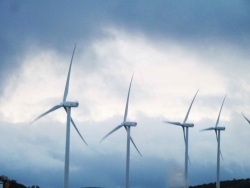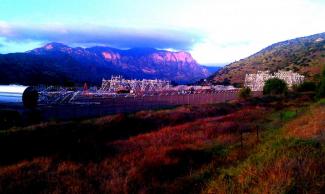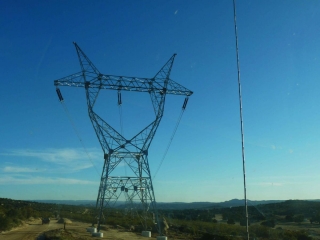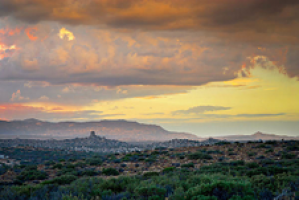
By Miriam Raftery
March 1, 2012 (San Diego’s East County) – What are the cumulative impacts on our region from the loss of federal, state and county public lands? In the span of just a few short years, we’ve lost vast tracts of our most beautiful properties once set aside by the federal, state and county governments as preserves for future generations. Wildfires, budget cuts, and now, massive energy projects are destroying our region's scenic wonders.
East County Magazine has sent our photographers into the wilds of San Diego’s East County, as well as just over the border into neighboring Imperial County, to document the destruction of our inland treasures.
Wildfires’ tragic cost
 The 2003 Cedar Fire burned 280,278 acres in San Diego County, including virtually all of the 24,700 acres of Cuyamaca Rancho State, decimating 99% of the East County landmark’s pine forests. Another 4,985 acres were destroyed in Anza-Borrego State Park. Other parks suffered damage as well.
The 2003 Cedar Fire burned 280,278 acres in San Diego County, including virtually all of the 24,700 acres of Cuyamaca Rancho State, decimating 99% of the East County landmark’s pine forests. Another 4,985 acres were destroyed in Anza-Borrego State Park. Other parks suffered damage as well.
The once verdant pines of Cuyamaca will not grow back in our lifetime, and with changing climate conditions, experts say this lost “ghost forest” may never return.
The fires also took a terrible toll on wildlife. Deer and mountain lions were found burned; habitat and foraging grounds were decimated for countless wild animals and birds.
 “We have been devastated,” said State Park Director Ruth Coleman in a news release after the 2003 fires. “The reports coming into my office are very disheartening. We have lost priceless cultural and historic structures. We have lost offices and other operations facilities. We have lost tens of thousands of acres of pristine wilderness and forests. Our people have suffered heavy personal losses by losing their homes. Our parks’ family is feeling a good deal of pain today.”
“We have been devastated,” said State Park Director Ruth Coleman in a news release after the 2003 fires. “The reports coming into my office are very disheartening. We have lost priceless cultural and historic structures. We have lost offices and other operations facilities. We have lost tens of thousands of acres of pristine wilderness and forests. Our people have suffered heavy personal losses by losing their homes. Our parks’ family is feeling a good deal of pain today.”
http://www.parks.ca.gov/pages/21299/files/oct%202003%20fires%20news%20release.pdf
 But sadly, more devastation followed. In 2007, the devastating Witch Creek, Poomacha, and Harris Fires forced a half million San Diego County residents to flee their homes. Among other devastating losses, the fire scorched 65% percent of Palomar State Park (1,250 acres). Portions of the Hauser National Wilderness area also burned.
But sadly, more devastation followed. In 2007, the devastating Witch Creek, Poomacha, and Harris Fires forced a half million San Diego County residents to flee their homes. Among other devastating losses, the fire scorched 65% percent of Palomar State Park (1,250 acres). Portions of the Hauser National Wilderness area also burned.
Federal lands opened to energy projects
One might think that after such heart-wrenching destruction of public lands and habitat, special care would be taken to protect our remaining parks and recreation areas. But sadly, that has not occurred.
 During the Bush administration, secret meetings between energy company executives and Vice President Dick Cheney resulted in the unprecedented opening up of publicly held lands for construction of massive energy projects in what formally became known as “energy corridors.”
During the Bush administration, secret meetings between energy company executives and Vice President Dick Cheney resulted in the unprecedented opening up of publicly held lands for construction of massive energy projects in what formally became known as “energy corridors.”
This environmentally destructive policy was embraced by the Obama administration in its quest for renewable energy projects to reduce greenhouse gas emissions and lessen dependence on foreign oil.
The fruits of seeds sown in those closed-door energy sessions are being reaped today by SDG&E and the manufacturers of massive wind turbines, solar farms and high-voltage power lines built, underway or planned across lands formerly reserved as national forests, wilderness or public recreation lands.
Inside the Energy Corridors
 Sunrise Powerlink has been called “the most devastating project I’ve ever seen” by San Diego Supervisor Dianne Jacob. The 117-mile-long high-voltage power lines slice through Cleveland National Forest.
Sunrise Powerlink has been called “the most devastating project I’ve ever seen” by San Diego Supervisor Dianne Jacob. The 117-mile-long high-voltage power lines slice through Cleveland National Forest.
Massive steel towers penetrate the heart of a county-designated scenic view corridor in Lakeside’s El Monte Valley, where towers now march across the face of El Cajon Mountain, known to locals as El Capitan for its resemblance to El Monte Valley.
Lakes and reservoirs have been invaded by the Powerlink, too.


The power lines continue their destructive march eastward through scenic areas Alpine, portions of Cleveland National Forest.
Power companies are even sawing the tops of mountains in some areas.

From there, the line runs onward through the McCain Valley federal recreation area on Bureau of Land Management property through rock y precipices in prime eagle habitat.
y precipices in prime eagle habitat.
Landmark rock formations that once seemed towering in scale now seem miniaturized as views have been obliterated by the power towers.

This is prime habitat for the Peninsular bighorn sheep, a threatened species set to also have its habitat diminished by a 10-mile-long solar farm proposed on public land in nearby Ocotillo. It is also a haven for nesting golden eagles, hawks, owls and other raptors, as well as cougars, deer and other wildlife. But now the roar of helicopters working seven days a week is disrupting the valley, along with dozens of construction trucks and lands scraped bare as staging areas, or fly yards, for the towers.

Beyond, the towers despoil views of high desert mountains and even a panoramic vista from the Desert View Tower in Jacumba, long a popular stop for visitors traveling from Arizona to San Diego.
These views have awed travelers for centuries, from Native Americans to Spanish colonists, from pioneers and stagecoach traveloers to motorists along the interstate highway here.

Native American tribes have filed suit to halt energy projects in Ocotillo, where rare cultural artifacts would be lost.
Towers dominate the desert landscape through Imperial County to Arizona.
High voltage lines now even occupy the once desolate dunes near El Centro, where off-road racing and dune buggy enthusiasts must now dodge towers that dwarf dunes of shifting sands that formerly looked like a scene out of the deserts of Arabia.


Paradise Lost—Coming Soon
There’s much more yet to come.
Even the new Powerlink towers in scenic McCain Valley will soon seem Lilliputian beside far taller wind turbines.
Tule Wind Farm, just approved by the U.S. Department of the Interior, will line the only road through McCain Valley--and the only entrance to the spectacular Carrizo Gorge and Sawtooth Wilderness regions—with 124 wind turbines.
Each will be over 450 feet tall—45 stories (a third the height of the World Trade Centers' twin towers lost in the 911 attacks) with blade spans larger than those on many commercial jet liners.
The whirling turbines will surround Cottonwood and Lark Campgrounds.
turbines will surround Cottonwood and Lark Campgrounds.

The Jacumba-Boulevard area is also slated for two proposed solar farms. Though not on public lands, these would total over 1,000 acres (larger than Balboa Park) and involved scraping the earth bare of habitat in an area already severely impacted by Powerlink, Tule Wind, and next up, the ECO power substation planned by SDG&E.
Park Closures
 As if all of these losses of public lands are not enough, state and federal park officials and our State Legislature have recently barred access to some of East County’s most cherished destinations—and two state parks in San Diego County face permanent closure come July.
As if all of these losses of public lands are not enough, state and federal park officials and our State Legislature have recently barred access to some of East County’s most cherished destinations—and two state parks in San Diego County face permanent closure come July.
Cedar Creek Falls, which lies within the Cleveland National Forest, has long been a favorite spot for backcountry hikers. Many visitors are shocked to learn of our best kept secret—a towering 200-foot-high waterfall plunging into a swimming hole that looks like a scene straight out of Shangri-La.
Last year, following trail improvements and a teen’s tragic death, the Forest Service shut down access to the falls. There have been several deaths and serious injuries through the years, as occurs occasionally at waterfalls in other wilderness locations, from Yosemite to Yellowstone. Signage at those locations clearly warn of dangers, but the park service doesn’t shut down access to the many eager visitors due to a few daredevils or people who fail to follow clearly posted directions.
Initially the Forest Service promised to reopen Cedar Creek Falls, also known as the Devil’s Punchbowl, last autumn. The closure has been extended until at least April 1. An e-mail this week sent by ECM to forest service officials resulted in no confirmation whether the falls will reopen to the public, nor any explanation of what improvements if any have been made during the eight months that the public has been denied access.
Compounding the loss, state budget cuts have led to reduced staffing at many state parks, with many seasonal closures. Some make sense in lean times, such as shuttering Anza Borrego Desert State Park in the heat of mid-summer, for example. 
The most baffling closure is that of Green Valley Falls in Cuyamaca Rancho State Park. This has been a favorite lure of young and old alike for generations in East County, with a trail easily accessible to all. The State Park Service has kept it shut down during fall, winter and now spring. A sign at the entrance says it will reopen in July. But who wants to visit a waterfall during the dry season? Are our days of splashing in crystal green pools at the base of a thunderous cascade of water gone forever?
At least these places are still protected as publicly owned parks, and someday may reopen intact. The same cannot be said, however, for 70 state parks slated for permanent closure July 1 due to budget cuts—including Palomar Mountain State Park and the San Pasqual Battlefield State Park in San Diego’s inland areas.





These are scenic wonderlands and places where the echoes of our past reside, a rich history that includes Native American cultural resources, pioneer heritage, and the landmark battle that turned the tide of the Mexican-American War.
At San Pasqual, re-enactors have annually brought to life the famous battle; will that cease when the visitor center goes dark ? Worse, these parks could be sold off to private buyers, padlocked or paved over-- the memories of those hard-fought battles and frontier spirits confined to the ashbin of history.
A Call to Action
East County Magazine calls on our elected representatives and public officials at the federal, state and local levels to take a hard look at the cumulative impacts of that our region has suffered from fires, budget cuts, and energy projects. It's time to halt the most destructive projects not yet built--and implement some moratoriums on robbing San Diego's inland region of any more of our public lands.
Just as many citizens speak out to prevent the looting of our public treasury, so, too, should we raise our voices to halt the decimation of our natural and historic treasures on our public lands.

Update: Two state parks in San Diego County have been spared from closure: Palomar Mountain State Park and San Pasqual Battlefield State Park, after nonprofit groups raised funds to temporarily keep them open by the July 2012 deadline. The U.S. Forest Service has reopened one of two trails to Cedar Creek Falls. On the down side, wildfires and gold-spotted beetles have devastated vast tracts of the remaining forests in our region as of fall 2012; the beetles alone have killed an estimated 12,000 trees locally. In addition, new wind farm proposals woudl target some of the most scenic remaining areas, including a towering waterfall.








Comments
Well said!
Excellent article. Thank you.
This is a heartbreaking
This is a heartbreaking story, Miriam, but it's important for people to know about the threats facing our rapidly vanishing East County open spaces. Thank you.
Could anything be more cruelly ironic than the destruction of beautiful wilderness in the name of "renewable" energy sources--i.e., windmill and solar panel farms? These so-called "green" plans and politicies strike me as being the ultimate environmental Trojan Horse!
What, if anything, can we do?
Craig, that is the right question; here are things to do.
On the Tule wind farm, I've heard it still needs approval of the County for the federal government to access County roads. So possibly the County Supervisors could play a role. I don't know if they can block the whole project or just minimize it.
Also you can send copies of this article to our federal representatives--you live in Duncan Hunter's district which will soon be Susan Davis's district, so you could contact them both. Susan Davis sits on key environmental committees in Congress. So does Senator Barbara Boxer. Senator Feinstein should be told what is happening too, if she doesn't already know. The wind farm is in Bob Filner's district, who is still in Congress until the end of the year. There are candidates running for his seat, Juan Vargas and Denise Ducheny, maybe others too, who could be approached.
The Citizens Action Center button on the top of our site will take you to a "Sound off" section where we have links to contact all of these federal officials. Here is the direct link: http://www.eastcountymagazine.org/0809soundoff
Letters to President Obama and the U.S. Secretary of the Interior are in order too.
I also recommend sending a copy of another story we wrote called "A Town Surrounded." It's about the impacts of multiple big energy projects on the Jacumba-Boulevard area. Similar sad stories could be told about some other areas out here. Here is the link: http://www.eastcountymagazine.org/node/8724
I also would love to see people asking other media outlets to cover this story - not just the San Diego media, but national. What's happening here is part of a plan that is unfolding across America on our public lands, or soon will. It should be material for 60 Minutes, 20/20, Mother Jones, CNN. I don't know if anyone has even brought these issues to their attention, but letters from citizens might help.
This has to stop
Senator Feinstein won't help - in Congressional Budget hearings 2 years ago she pressured the Forest Service to get on with approval of the Powerlink. It was no surprise to check her campaign contributions and find that SDG&E, PG&E, and other utilities were donors to her coffers. I also repeatedly asked Senator Boxer to take a stand against the Powerlink and she did not even return my calls or emails. Let's clean house! Also, it is vitally important to support local area generation on rooftops, carports, etc so that there can be no justification for adding more towers and parallel transmission lines. We must make sure that the demand for power does not increase in SD County or the greedy SDG&E will force another powerline on us - for their own profit.
Also....there IS a saner green alternative
Jim Bell spoke yesterday at Forging a Sustainable Future about how we could meet 100% of San Diego County's power needs without Sunrise Powerlink or any destructive wind farms or even solar farms. How? Convert even a modest amount of rooftops to solar, and build parking lot shade covers with solar on them. Simple! The problem is no corporations are advocating for this. He's done calculations showing that installing all that solar, plus adding conservation measures and putting people to work installing those, would actually generate a net meter profit over time, instead of importing expensive energy across those giant power lines.
Maybe we need citizens and solar advocates to join together and scream from the rooftops that this is the sane solution --not descrating our wilderness, rural lands and small towns across America. I'd love to see a million people across America standing on their rooftops, screaming out to be allowed to be energy producers and get paid -- instead of paying Spanish wind turbine makers and destructive companies like SDG&E.
The Saner Alternative
Every time I fly into LAX and see those miles of flat warehouse rooftops baking in the sun, I think of that saner alternative Jim Bell talks about. And the tragic, reprehensible thing is that the federal government is required by law to consider alternative ways of meeting the purpose of and need for the desert wind and solar projects, but the BLM has so hashed up the environmental impact assessment process that it's been able to squirm out from under its legal responsibilities -- or will be able to if affected citizens don't stand up (with their lawyers) and take action. It's plainly obvious that we ought to pick the low-hanging fruit of rooftop solor before we give the desert to the energy industry, however green it purports to be. But the administration refuses to even consider this, despite the clear requirements of law.